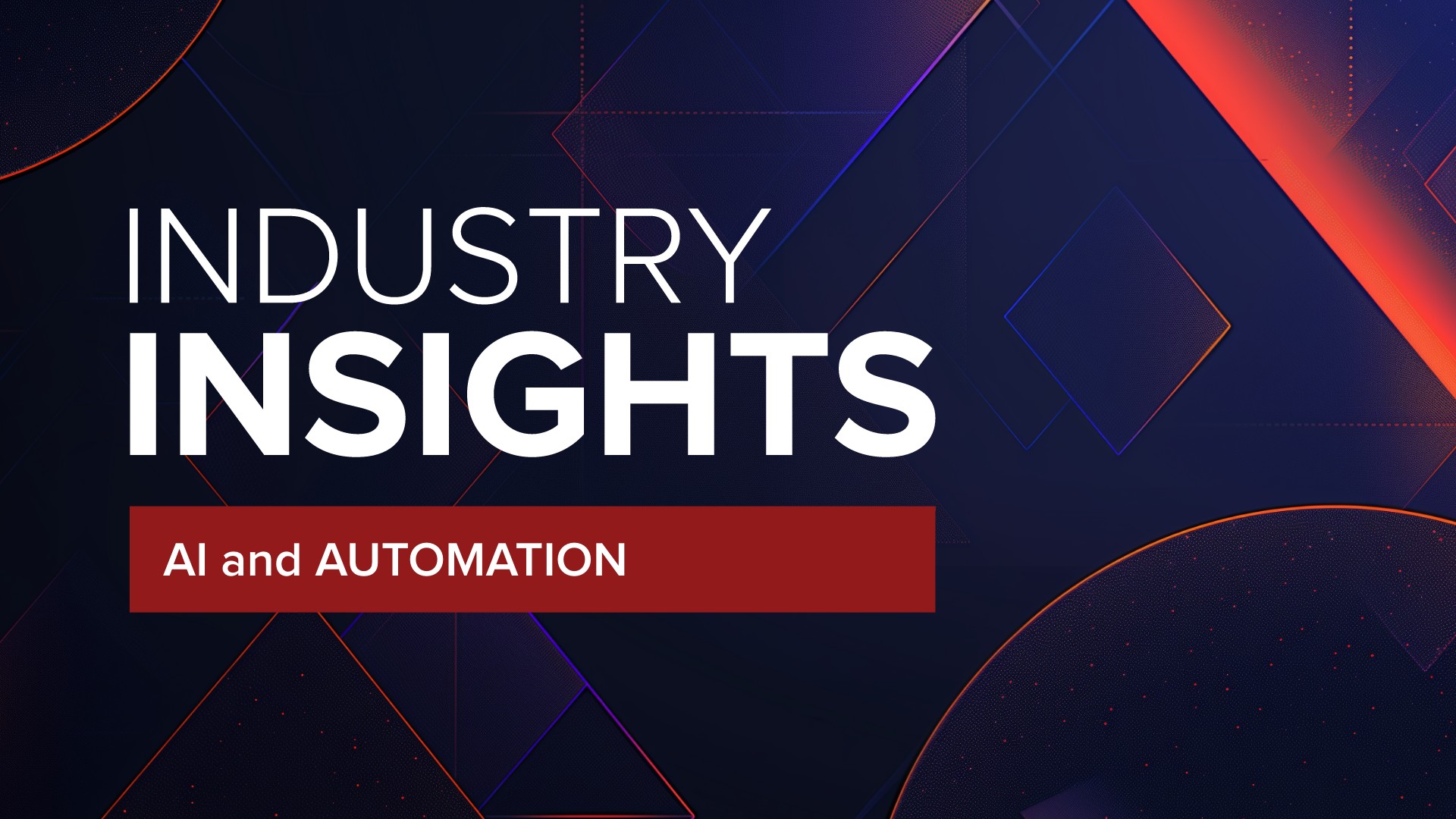Industry Insights: Navigating the future of broadcast with AI and automation

Subscribe to NCS for the latest news, project case studies and product announcements in broadcast technology, creative design and engineering delivered to your inbox.
In this installment of NewscastStudio’s Industry Insights series, we delve into the transformative effects of automation, machine learning and AI in broadcast. Part one of our vendor discussion focuses on how these technologies are reshaping broadcast production, from enhancing efficiency and creativity to addressing the challenges and ethical considerations of integration.
From the potential to enhance creativity to the challenges of integration and the ethical considerations it raises, this roundtable discussion illuminates the complex yet exciting trajectory of AI in broadcasting.
Key takeaways from the Industry Insights roundtable
- Generative AI, while currently more hype than reality in high-end broadcast applications, is beginning to show promise in automating content creation and enhancing monitoring and recommendation engines.
- AI and machine learning are not just buzzwords but are already transforming traditional broadcast production processes, making them more efficient and allowing for creative content generation through automated workflows.
- Automation and AI are reshaping the roles within broadcast production teams, emphasizing the importance of training and adapting to leverage these technologies for creative and efficient content production.
- Integrating AI into broadcast production faces challenges, including data quality, workflow compatibility and the fear of job displacement, highlighting the importance of thoughtful implementation.
- Ethical considerations around data privacy, consent and the potential for bias in AI algorithms underline the need for transparency and editorial integrity in AI-enhanced content creation.
Is AI in broadcast a buzzword, a new form of automation or a breakthrough?
Neil Maycock, chief commercial officer, Pebble: Probably all three, right now generative AI is closer to buzzword hype with very little real-world content being created for high-end broadcast and media applications. As a new form of automation AI is gaining traction, from recommendation engines, speech to text conversions, through to more advanced forms of monitoring.
Mathieu Planche, CEO, Witbe: While certainly trendy, AI is far more than a buzzword — it represents a breakthrough in automation. AI and machine learning have already helped revamp numerous practical processes, and I have no doubt that additional applications for the technologies will be revealed over the next few years.
Paddy Taylor, head of broadcast, MRMC: It’s a buzzword. Most of what people refer to in video production isn’t AI but is more a case of predictive automation with machine learning. That said I wouldn’t downplay its significance, if used appropriately the potential is huge.
Jay Prasad, CEO, Relo Metrics: AI may seem like a recent technology with all the constant hype and daily headlines, but the reality is some form of this technology has been with us for decades. And even though AI has pervaded all aspects of our daily work and personal lives, we’ve still barely begun to comprehend the technology’s seemingly limitless potential.
Charles Dautremont, CTO, Cinedeck: AI is everywhere in the broadcast and media industry now, with every content organization exploring it to some depth, if not implementing it in all corners of their workflows. However, the definition of what AI actually means to the industry appears to be heavily varied. For the most part, AI seems to have been presented recently as a new form of automation allowing for an insight into AI content generation and a breakthrough into automated production workflows.
What discussions are you having with broadcasters about automation and AI?
Gerhard Lang, CTO, Vizrt: Many of our customers align with our belief that AI can serve as a facilitator for producing high-quality shows in situations where not all essential talent is readily available. And, since AI-driven automation improves efficiency and removes complexity, it’s becoming an important part of enhancing content. Additionally, AI can play a role in maintaining corporate identity, particularly when a show is produced in a smaller local station.
Mathieu Planche, CEO, Witbe: Witbe is consistently talking with broadcasters about the myriad of ways that automation can help streamline their processes, lighten their workloads, and improve team collaboration. With providers who have already implemented automation, we’ve also been talking about the future of AI in the testing space and where they’d be most interested in seeing innovation.
Abhijit Dey, general manager and COO, Perifery: The discussions we’ve had with broadcasters about AI and automation cover multiple workflow aspects from AI-enriched metadata creation at ingest to metadata integration with files, automated packaging for OTT distribution, and prioritizing archiving for upstream benefits.
Paddy Taylor, head of broadcast, MRMC: Camera automation in its rawest sense is still seen as a holy grail in the world of Studio Automation. We have customers using Polymotion Chat in all environments from houses of worship, production studios, shopping TV through to Tier 1 broadcasters using it for news and live studios. The system can be used fully autonomously, and we are seeing more customers use it this way; however, there are still some concerns about allowing a piece of software to do a job that camera operators have done for many years.
James Fraser, VP for U.S. sales, Newsbridge: The majority of broadcasters we talk to are looking for business efficiencies related to content discovery, logging, and repurposing. Two frequently hot topics are the desire to rely less on the knowledge of an archivist for locating specific content and the ability to repurpose content, enabling broadcasters to tap into additional cost savings.
How are AI and machine learning transforming traditional broadcast production processes?
Gerhard Lang, CTO, Vizrt: When it comes to creating rundowns and automation, AI is already, to a certain extent, playing an important role. This is only due to expand, as the need to have an automation system that supports changes to content right up to the point of distribution is crucial to make it better quality and more accessible. AI is helping simplify the broadcast production process, eliminating time-consuming tasks for operators, and keeping up with demand from 24-hour audiences.
Steph Lone, global leader of solutions architecture for media and entertainment, Amazon Web Services: We have seen caption generation as a common AI/ML application in live production for Tier 2 and Tier 3 live events, especially sports. Many live sports productions also include real-time win probability statistics and advanced insights utilizing simulations, like Monte Carlo simulations, to predict possible game outcomes. Utilizing AI/ML technologies to compile sizzle and highlight reels, as well as social media clips is fairly commonplace in this industry segment.
Paddy Taylor, head of broadcast, MRMC: At this stage, they are being used to streamline and simplify processes, an automation system can learn the type of events you typically use and suggest a sequence that is 95+% correct reducing the time taken to handle typical tasks.
Vinayak Shrivastav, co-founder and CEO, VideoVerse: AI-based video editors have been trained on extensive datasets related to the broadcaster’s content. Because of this training, the model can quickly find the content they need from live footage through the use of meta-tags. Now broadcasters can produce the most relevant content in a far more efficient workflow, giving fans what they need when they want it the most.
Jay Prasad, CEO, Relo Metrics: AI is impacting every aspect of traditional broadcast and production workflows: how content is created, edited, distributed, delivered, shared — and monetized. Beyond traditional production operations, large-language models (LLM) based on Generative AI and machine learning are ideal for such tasks as translation and dubbing, as well as reshaping and streamlining content localization.
Charles Dautremont, CTO, Cinedeck: AI and machine learning are slowly but surely transforming the way content providers interact with broadcast production processes. Most broadcast equipment providers are exploring the integration of AI in some form, and it is already becoming common for content organizations to re-evaluate how their workflows might benefit from the implementation of AI. Automation in the form of AI and ML is taking the broadcast industry by storm, providing an answer to the fast completion of manual, tedious tasks — making room for more creative use of talent in the workplace.
What are the challenges and limitations of integrating AI into existing broadcast production workflows?
Neil Maycock, chief commercial officer, Pebble: Current AI engines are still far from perfect, with one of the core issues that they are dependent on data used to train the AI model. This means they can suffer from the old software adage “garbage in, garbage out,” there are plenty of high-level public examples of AI getting things wrong. For now, we’re not at the stage of human being made redundant from broadcast production workflows, but there is real opportunity for AI tools to increase their productivity.
Gerhard Lang, CTO, Vizrt: Some people occasionally feel threatened by AI, harboring a sense of mistrust and fearing potential job elimination. Throughout Vizrt’s history, we’ve encountered similar concerns with the introduction of new technologies. But our belief remains steadfast: when technology is applied correctly, it serves as a helper and enabler. We develop our products with this goal in mind, ensuring that technology enhances rather than diminishes the human experience.
James Fraser, VP for U.S. sales, Newsbridge: AI technology is continually advancing. What wasn’t possible yesterday is conceivable today. It’s an ongoing process to educate and encourage broadcasters to integrate AI into their everyday workflows. Broadcasters need to be comfortable with the fact that their production workflows will continue to evolve as the technology improves.
Charles Dautremont, CTO, Cinedeck: The issue here is that many of the existing broadcast production workflows we have built are not suited for the integration of AI, ML and automation. These workflows provide questions and challenges that the integration of AI would address, but the solution often cannot be implemented in its current state. The challenges, therefore, of integrating AI into our existing workflows is to make the infrastructure AI friendly first, ensuring that AI is only addressing the challenges we need it to – not creating more issues for us to tackle down the line.
What ethical considerations are raised by the use of AI in broadcast content creation?
Lara Guerard, principal solutions director, TMT Insights: The use of AI in broadcast content creation raises several ethical considerations, including concerns about data privacy and consent, as AI systems often rely on large datasets of viewer information. There’s also the risk of bias in AI algorithms, which can lead to unfair representation or stereotyping, as well as the potential for deep fakes and manipulated content that raise questions about authenticity and trust in the media. Ensuring transparency in how AI is used and maintaining editorial integrity are key ethical challenges in this domain.
How is automation impacting the roles and skills required in broadcast production teams?
Neil Maycock, chief commercial officer, Pebble: Greater automation has been a theme in media technology for a number of years. The proliferation of content and distribution platforms has been behind the mantra for doing more for less. AI is the latest, and very powerful, tool which has the potential to transform working models eliminating mundane tasks and allowing production teams to focus on highly skilled and creative requirements.
Abhijit Dey, general manager and COO, Perifery: Automation shifts broadcast production roles, enhancing productivity for those that are adept at using AI tools. With automation, broadcast production team members are empowered to focus on creativity, allowing them to delegate repetitive and organizational tasks to AI, aligning with the principle of automating non-cognitive tasks.
Paddy Taylor, head of broadcast, MRMC: The trend for some time has been to get engineering and scheduling teams to take on more responsibilities. Some of these are not ideal for highly skilled staff and the ability to use automation to handle the more mundane tasks frees technical resources to work on more ambitious or critical projects. I think we need to be careful that we don’t rely too quickly and too heavily on the new tools we are seeing come to market as the core skills are still important.
How are broadcasters preparing their workforce for the integration of AI and automation in production processes?
Paddy Taylor, head of broadcast, MRMC: I am not sure they are specifically. It is more of a gradual submission rather than an all-out embrace. I have spoken with a few senior engineers who have championed what could be possible and tasked staff with learning and investigating how the latest AI tools can be deployed but for the most part, this is being driven by the traditional vendors.
Charles Dautremont, CTO, Cinedeck: The main priority for many organizations is finding the right balance between the role of team members and the support that AI can provide. One of the best ways to prepare our workforces for the integration of AI and automation is to re-evaluate the infrastructure and necessary elements of our production processes, assign a suitable need for AI and integrate where it is appropriate to do so. A good example is any manual and tedious tasks that could save time if done by AI (but don’t require human creativity and input to function correctly), such as captioning and tagging in the content editing process.
How is AI influencing the cost and scalability of broadcast production operations?
Mathieu Planche, CEO, Witbe: One of the goals for the industry should be to make scalability more attainable for service providers with the help of AI. A good example is Witbe’s Smart Navigate AI algorithm — implemented over the last year — which allows teams to script test scenarios 10 times faster than before. Not only does this lower costs by reducing workloads, it allows testing to be scaled much more quickly.
Vinayak Shrivastav, co-founder and CEO, VideoVerse: Previously, broadcasters had to spend significantly on man-hours to scale their production operations. AI eliminates this trade-off, enabling them to drive down costs while also increasing scalability. Now a team that would have been handcuffed with traditional video production can produce more broadcast content than ever before.
James Fraser, VP for U.S. sales, Newsbridge: AI drastically reduces the time it takes to build a story. Traditionally, putting together a news package is a two to four-hour process, and 50% of that time is spent just on sourcing content. With AI, broadcasters can boost story production efficiency by as much as 70% and increase their content output.
Charles Dautremont, CTO, Cinedeck: One of the most exciting things about the introduction of AI into broadcast production operations is the sudden and astronomical scalability available to the industry. However, there is an argument to be made for the cost of AI solutions and automated implementation, with many organizations not able to afford the infrastructure foundation necessary to support an AI and automation-based system solution. With that being said, once AI is implemented into broadcast workflows, automation can prevent most manual tasks, and so can be financially preferable for many content delivery and post-production scenarios.
Explore more from this roundtable
Subscribe to NCS for the latest news, project case studies and product announcements in broadcast technology, creative design and engineering delivered to your inbox.






tags
Abhijit Dey, Amazon Web Services, Artificial Intelligence, Automation, AWS, Broadcast Automation, Charles d'Autremont, Cinedeck, Gerhard Lang, James Fraser, Jay Prasad, Lara Guerard, machine learning, Mathieu Planche, MRMC, Neil Maycock, Newsbridge, Paddy Taylor, Pebble, Perifery, Relo Metrics, Steph Lone, TMT Insights, VideoVerse, Vinayak Shrivastav, Vizrt, Witbe
categories
Broadcast Automation, Broadcast Engineering, Heroes, Industry Insights, Voices